8.3: Free Soil, Free Labor, Free Men
- Page ID
- 86145
\( \newcommand{\vecs}[1]{\overset { \scriptstyle \rightharpoonup} {\mathbf{#1}} } \)
\( \newcommand{\vecd}[1]{\overset{-\!-\!\rightharpoonup}{\vphantom{a}\smash {#1}}} \)
\( \newcommand{\id}{\mathrm{id}}\) \( \newcommand{\Span}{\mathrm{span}}\)
( \newcommand{\kernel}{\mathrm{null}\,}\) \( \newcommand{\range}{\mathrm{range}\,}\)
\( \newcommand{\RealPart}{\mathrm{Re}}\) \( \newcommand{\ImaginaryPart}{\mathrm{Im}}\)
\( \newcommand{\Argument}{\mathrm{Arg}}\) \( \newcommand{\norm}[1]{\| #1 \|}\)
\( \newcommand{\inner}[2]{\langle #1, #2 \rangle}\)
\( \newcommand{\Span}{\mathrm{span}}\)
\( \newcommand{\id}{\mathrm{id}}\)
\( \newcommand{\Span}{\mathrm{span}}\)
\( \newcommand{\kernel}{\mathrm{null}\,}\)
\( \newcommand{\range}{\mathrm{range}\,}\)
\( \newcommand{\RealPart}{\mathrm{Re}}\)
\( \newcommand{\ImaginaryPart}{\mathrm{Im}}\)
\( \newcommand{\Argument}{\mathrm{Arg}}\)
\( \newcommand{\norm}[1]{\| #1 \|}\)
\( \newcommand{\inner}[2]{\langle #1, #2 \rangle}\)
\( \newcommand{\Span}{\mathrm{span}}\) \( \newcommand{\AA}{\unicode[.8,0]{x212B}}\)
\( \newcommand{\vectorA}[1]{\vec{#1}} % arrow\)
\( \newcommand{\vectorAt}[1]{\vec{\text{#1}}} % arrow\)
\( \newcommand{\vectorB}[1]{\overset { \scriptstyle \rightharpoonup} {\mathbf{#1}} } \)
\( \newcommand{\vectorC}[1]{\textbf{#1}} \)
\( \newcommand{\vectorD}[1]{\overrightarrow{#1}} \)
\( \newcommand{\vectorDt}[1]{\overrightarrow{\text{#1}}} \)
\( \newcommand{\vectE}[1]{\overset{-\!-\!\rightharpoonup}{\vphantom{a}\smash{\mathbf {#1}}}} \)
\( \newcommand{\vecs}[1]{\overset { \scriptstyle \rightharpoonup} {\mathbf{#1}} } \)
\( \newcommand{\vecd}[1]{\overset{-\!-\!\rightharpoonup}{\vphantom{a}\smash {#1}}} \)
\(\newcommand{\avec}{\mathbf a}\) \(\newcommand{\bvec}{\mathbf b}\) \(\newcommand{\cvec}{\mathbf c}\) \(\newcommand{\dvec}{\mathbf d}\) \(\newcommand{\dtil}{\widetilde{\mathbf d}}\) \(\newcommand{\evec}{\mathbf e}\) \(\newcommand{\fvec}{\mathbf f}\) \(\newcommand{\nvec}{\mathbf n}\) \(\newcommand{\pvec}{\mathbf p}\) \(\newcommand{\qvec}{\mathbf q}\) \(\newcommand{\svec}{\mathbf s}\) \(\newcommand{\tvec}{\mathbf t}\) \(\newcommand{\uvec}{\mathbf u}\) \(\newcommand{\vvec}{\mathbf v}\) \(\newcommand{\wvec}{\mathbf w}\) \(\newcommand{\xvec}{\mathbf x}\) \(\newcommand{\yvec}{\mathbf y}\) \(\newcommand{\zvec}{\mathbf z}\) \(\newcommand{\rvec}{\mathbf r}\) \(\newcommand{\mvec}{\mathbf m}\) \(\newcommand{\zerovec}{\mathbf 0}\) \(\newcommand{\onevec}{\mathbf 1}\) \(\newcommand{\real}{\mathbb R}\) \(\newcommand{\twovec}[2]{\left[\begin{array}{r}#1 \\ #2 \end{array}\right]}\) \(\newcommand{\ctwovec}[2]{\left[\begin{array}{c}#1 \\ #2 \end{array}\right]}\) \(\newcommand{\threevec}[3]{\left[\begin{array}{r}#1 \\ #2 \\ #3 \end{array}\right]}\) \(\newcommand{\cthreevec}[3]{\left[\begin{array}{c}#1 \\ #2 \\ #3 \end{array}\right]}\) \(\newcommand{\fourvec}[4]{\left[\begin{array}{r}#1 \\ #2 \\ #3 \\ #4 \end{array}\right]}\) \(\newcommand{\cfourvec}[4]{\left[\begin{array}{c}#1 \\ #2 \\ #3 \\ #4 \end{array}\right]}\) \(\newcommand{\fivevec}[5]{\left[\begin{array}{r}#1 \\ #2 \\ #3 \\ #4 \\ #5 \\ \end{array}\right]}\) \(\newcommand{\cfivevec}[5]{\left[\begin{array}{c}#1 \\ #2 \\ #3 \\ #4 \\ #5 \\ \end{array}\right]}\) \(\newcommand{\mattwo}[4]{\left[\begin{array}{rr}#1 \amp #2 \\ #3 \amp #4 \\ \end{array}\right]}\) \(\newcommand{\laspan}[1]{\text{Span}\{#1\}}\) \(\newcommand{\bcal}{\cal B}\) \(\newcommand{\ccal}{\cal C}\) \(\newcommand{\scal}{\cal S}\) \(\newcommand{\wcal}{\cal W}\) \(\newcommand{\ecal}{\cal E}\) \(\newcommand{\coords}[2]{\left\{#1\right\}_{#2}}\) \(\newcommand{\gray}[1]{\color{gray}{#1}}\) \(\newcommand{\lgray}[1]{\color{lightgray}{#1}}\) \(\newcommand{\rank}{\operatorname{rank}}\) \(\newcommand{\row}{\text{Row}}\) \(\newcommand{\col}{\text{Col}}\) \(\renewcommand{\row}{\text{Row}}\) \(\newcommand{\nul}{\text{Nul}}\) \(\newcommand{\var}{\text{Var}}\) \(\newcommand{\corr}{\text{corr}}\) \(\newcommand{\len}[1]{\left|#1\right|}\) \(\newcommand{\bbar}{\overline{\bvec}}\) \(\newcommand{\bhat}{\widehat{\bvec}}\) \(\newcommand{\bperp}{\bvec^\perp}\) \(\newcommand{\xhat}{\widehat{\xvec}}\) \(\newcommand{\vhat}{\widehat{\vvec}}\) \(\newcommand{\uhat}{\widehat{\uvec}}\) \(\newcommand{\what}{\widehat{\wvec}}\) \(\newcommand{\Sighat}{\widehat{\Sigma}}\) \(\newcommand{\lt}{<}\) \(\newcommand{\gt}{>}\) \(\newcommand{\amp}{&}\) \(\definecolor{fillinmathshade}{gray}{0.9}\)Free Soil, Free Labor, Free Men
The conclusion of the Mexican War gave rise to the 1848 Treaty of Guadeloupe Hidalgo. The treaty infuriated anti-slavery leaders in the United States. The spoils gained from the Mexican War were impressive, but it was clear they would help expand slavery. In the end, the United States brokered a deal to purchase the California and New Mexico Territories for $15 million dollars. This acquisition included lands that would become the future states of California, Utah, Nevada, most of Arizona, and well as parts of New Mexico, Colorado, and Wyoming. Also in 1848, the administration worked to create the Oregon Territory.
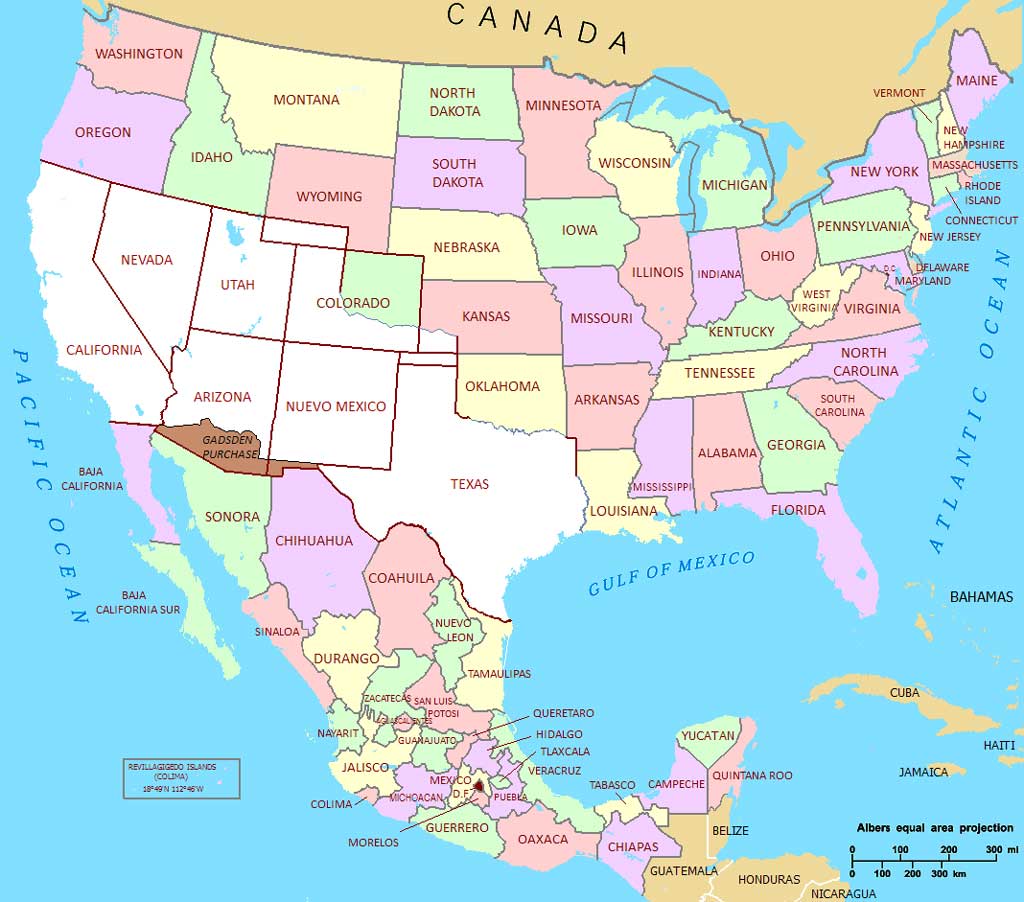
The Mexican Cession agreed by Mexico (white) and the Gadsden Purchase (brown). Part of the area marked as Gadsden Purchase near modern-day Mesilla, New Mexico, was disputed after the Treaty.
The acquisition of so much land made it imperative to anti-slavery leaders that these lands not be opened to slavery. But knowing that the Liberty Party was not likely to provide a home to many moderate voters, leaders instead hoped to foster a new and more competitive party, which they called the Free Soil Party (Figure 6). Anti-slavery leaders came into the 1848 election hoping that their vision of a federal government divorced from slavery might be heard. But both the Whigs and the Democrats, nominated pro-slavery southerners. Left unrepresented, anti-slavery Free Soil leaders swung into action.
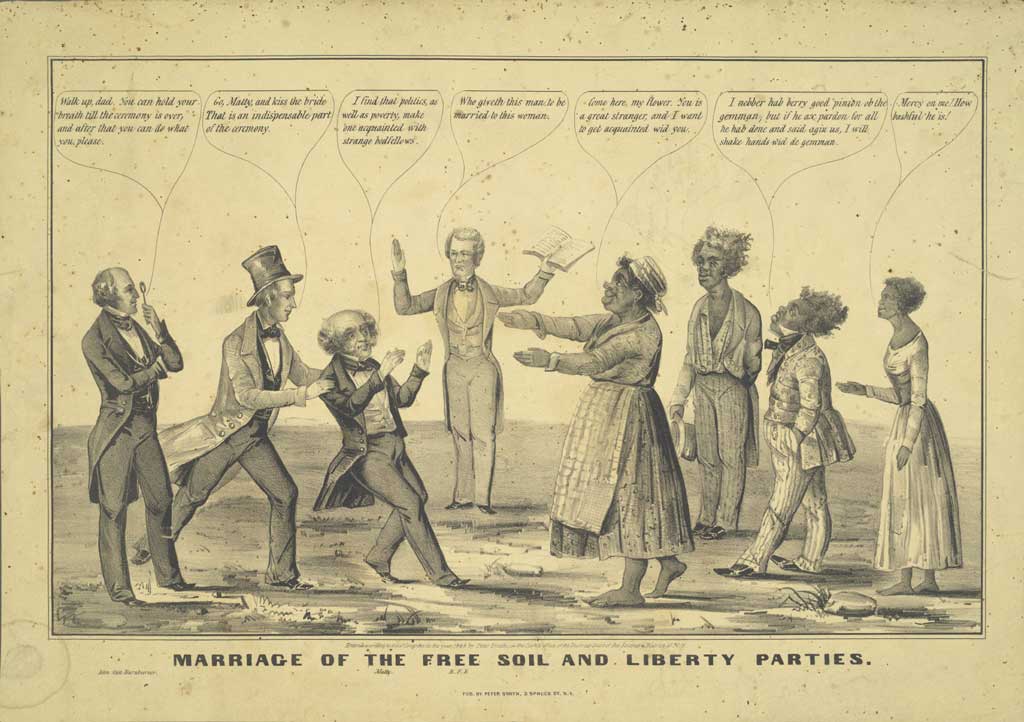
1848 political caricature which savagely satirizes the fact that though the presidential nominee of the newly-formed Free Soil Party, Martin Van Buren, was not himself an abolitionist, he was receiving the support of many abolitionists who had formerly been involved with the Liberty Party. To represent this, Martin van Buren (left of center) is shown symbolically marrying a black woman. The figure on the far left is presumably Van Buren’s son, John Van Buren, while the presiding clergyman in the center (“BFB”) is probably Benjamin F. Butler.
Demanding an alternative to the pro-slavery status quo, Free Soil leaders assembled so-called “Conscience Whigs,” like those found in Massachusetts under Charles Francis Adams, alongside western ex-Liberty Party leaders like Salmon P. Chase of Ohio. The new coalition called for a national convention in August 1848 at Buffalo, New York. A number of ex-Democrats committed to the party right away, including an important group of New Yorkers loyal to Martin Van Buren. The Free Soil Party’s platform bridged the eastern and the western leadership together and called for an end to slavery in Washington DC and a halt on slavery’s expansion in the territories. The Free Soil movement hardly made a dent in the 1848 Presidential election, but it drew more than four times the popular vote that the Liberty Party had won earlier. It was a promising start. In 1848, Free Soil leaders claimed just 10% of the popular vote, but won over a dozen House seats, and even managed to win one Senate seat in Ohio, which went to Salmon P. Chase. In Congress, Free Soil members had enough votes to swing power to either the Whigs or the Democrats.
The admission of Wisconsin as a free state in May 1848 helped cool tensions after the Texas and Florida admissions. But news from a number of failed revolutions in Europe alarmed American reformers. As exiled radicals filtered out of Europe and into the United States, a women’s rights movement also got underway in July at Seneca Falls, New York. Representing the first of such meetings ever held in United States history, it was led by figures like Elizabeth Cady Stanton and Lucretia Mott, women with deep ties to the abolitionist cause (Figure 7). Frederick Douglass also appeared at the convention and took part in the proceedings, where participants debated the Declaration of Sentiments, Grievances and Resolutions. By August 1848, it seemed plausible that the Free Soil Movement might tap into these reforms and build a broader coalition. In some ways that is precisely what it did. But come November, the spirit of reform failed to yield much at the polls. Whig candidate Zachary Taylor bested Democrat Lewis Cass of Michigan.

U.S. postage stamp commemorating the Seneca Falls Convention titled 100 Years of Progress of Women: 1848-1948 (Elizabeth Cady Stanton on left, Carrie Chapman Catt in middle, Lucretia Mott on right.)
The upheavals signaled by 1848 came to a quick end. Taylor remained in office only a brief time until his unexpected death from a stomach ailment in 1850. During Taylor’s brief time in office, the fruits of the Mexican War began to spoil, threatening the whole country with sickness. While he was alive, Taylor and his administration struggled to find a good remedy. Increased clamoring for the admission of California, New Mexico, and Utah pushed the country closer to the edge. Gold had been discovered in California, and as thousands continued to pour onto the West Coast and through the trans-Mississippi West, the admission of new states loomed. In Utah, Mormons were also making claims to an independent state they called Deseret. By 1850, California wanted admission as a slave state. With so many competing dynamics underway, and with the President dead and replaced by Whig Millard Fillmore, the 1850s were off to a troubling start.
Congressional leaders like Henry Clay and newer legislators like Stephen A. Douglas of Illinois were asked to broker a compromise, but this time it was clear no compromise could bridge all the diverging interests at play in the country. Clay eventually left Washington disheartened by affairs. It fell to young Stephen Douglas, then, to shepherd the bills through the Congress, which he in fact did. Legislators rallied behind the “Compromise of 1850,” an assemblage of bills passed late in 1850, managed to keep the promises of the Missouri Compromise alive.
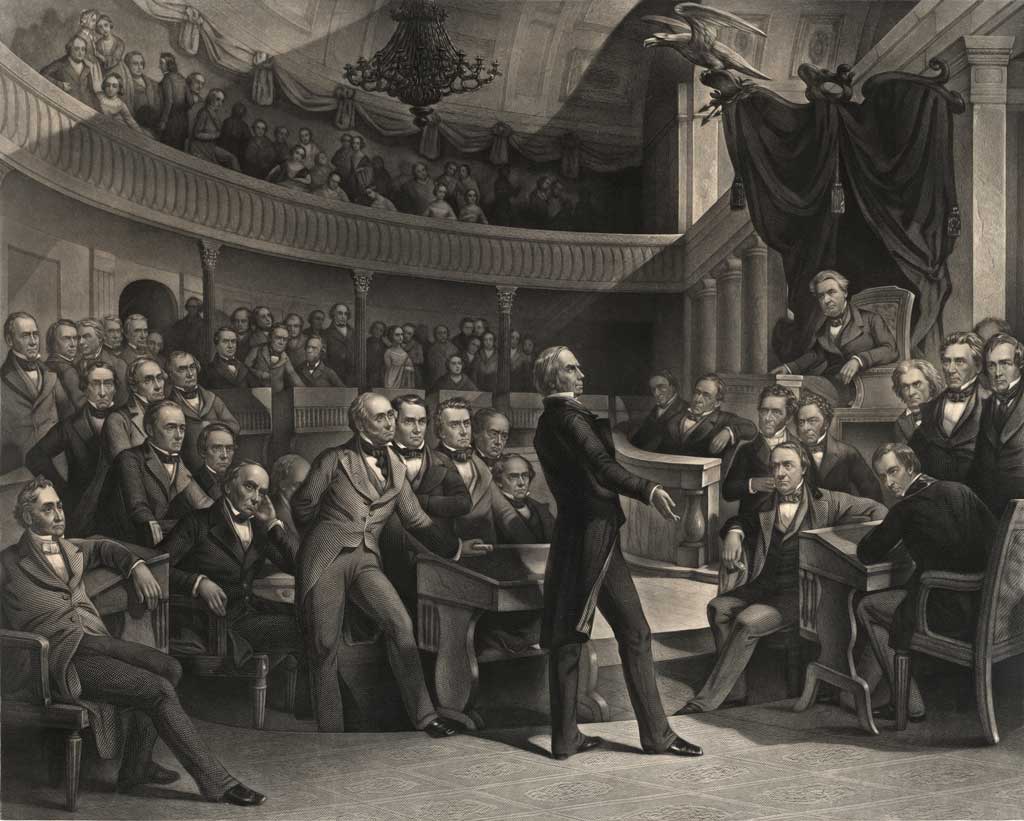
This engraving depicts the Golden Age of the United States Senate in the Old Senate Chamber, site of many of the institution’s most memorable events. Here, Henry Clay, “the Great Compromiser,” introduces the Compromise of 1850 in his last significant act as a senator. In a desperate attempt to prevent war from erupting, the “Great Triumvirate,” of Daniel Webster of Massachusetts, John C. Calhoun of South Carolina, and Clay of Kentucky struggled to balance the interests of the North, South, and West. This image shows all three men, with Clay at center stage, presenting his compromise to the Senate. Daniel Webster is seated to the left of Clay and John C. Calhoun to the left of the chair of the presiding officer, Vice President Millard Fillmore.
The Compromise of 1850 tried to offer something to everyone, but in the end it only worsened the sectional crisis. For southerners, the package offered a tough new fugitive slave law that empowered the federal government to deputize regular citizens in assisting with the arrest of runaways. The New Mexico territory, meanwhile, newly buttressed by additional lands from the nearby State of Texas, (Texas gave away some of its lands to erase some of its debts) and the Utah Territory, would be allowed to determine their own fates as slave or free states based on popular sovereignty. The Compromise also allowed territories to submit suits directly to the Supreme Court over the status of fugitive slaves within its bounds.
The admission of California as the newest free state in the Union cheered many northerners, but even the admission of a vast new state full of resources and rich agricultural lands did not fully satisfy many northerners. In addition to California, northerners also gained a ban on the slave trade in Washington, D.C., but not the full emancipation abolitionists had long strived for. Texas, which had already come into the Union as a slave state, was asked to give its lands up and give them to New Mexico. This, proponents argued, might limit the number of representatives Texas could send as a slave state, and in the process help perhaps bolster the number of free state voters in New Mexico. But the Compromise debates soon grew ugly.
After the Compromise of 1850 debates, anti-slavery critics became increasingly certain that slaveholders had co-opted the federal government, and that a southern “Slave Power” secretly held sway in Washington, where it hoped to use its representative advantages, built into the 3/5 compromise of the Constitution, to make slavery a national institution. This idea had floated around anti-slavery circles for years, but in the 1850s anti-slavery leaders increasingly argued that Washington worked on behalf of slaveholders while ignoring the interests of white working men.
The 1852 Presidential election gave the Whigs their most stunning defeat and effectively ended their existence as a national political party. Whigs captured just 42 of the 254 electoral votes needed to win. With the Compromise of 1850 in place, with plenty of new lands for white settlers to improve, everything seemed in its right place for a peaceful consensus to re-emerge. Anti-slavery feelings continued to run deep, however, and their depth revealed that with a Democratic Party misstep, a coalition united against the Democrats might yet emerge and bring them to defeat. One measure of the popularity of anti-slavery ideas came in 1852 when Harriet Beecher Stowe (Figure 9) published her bestselling anti-slavery novel, Uncle Tom’s Cabin (Figure 10). Sales for Uncle Tom’s Cabin were astronomical, eclipsed only by sales of the Bible. The book became a sensation and helped move antislavery into everyday conversation for many northerners. Despite the powerful antislavery message, Stowe’s book also reinforced many racist stereotypes. Even abolitionists struggled with the deeply ingrained racism that plagued American society. While the major success of Uncle Tom’s Cabin bolstered the abolitionist cause, the terms outlined by the Compromise of 1850 appeared strong enough to keep the peace.

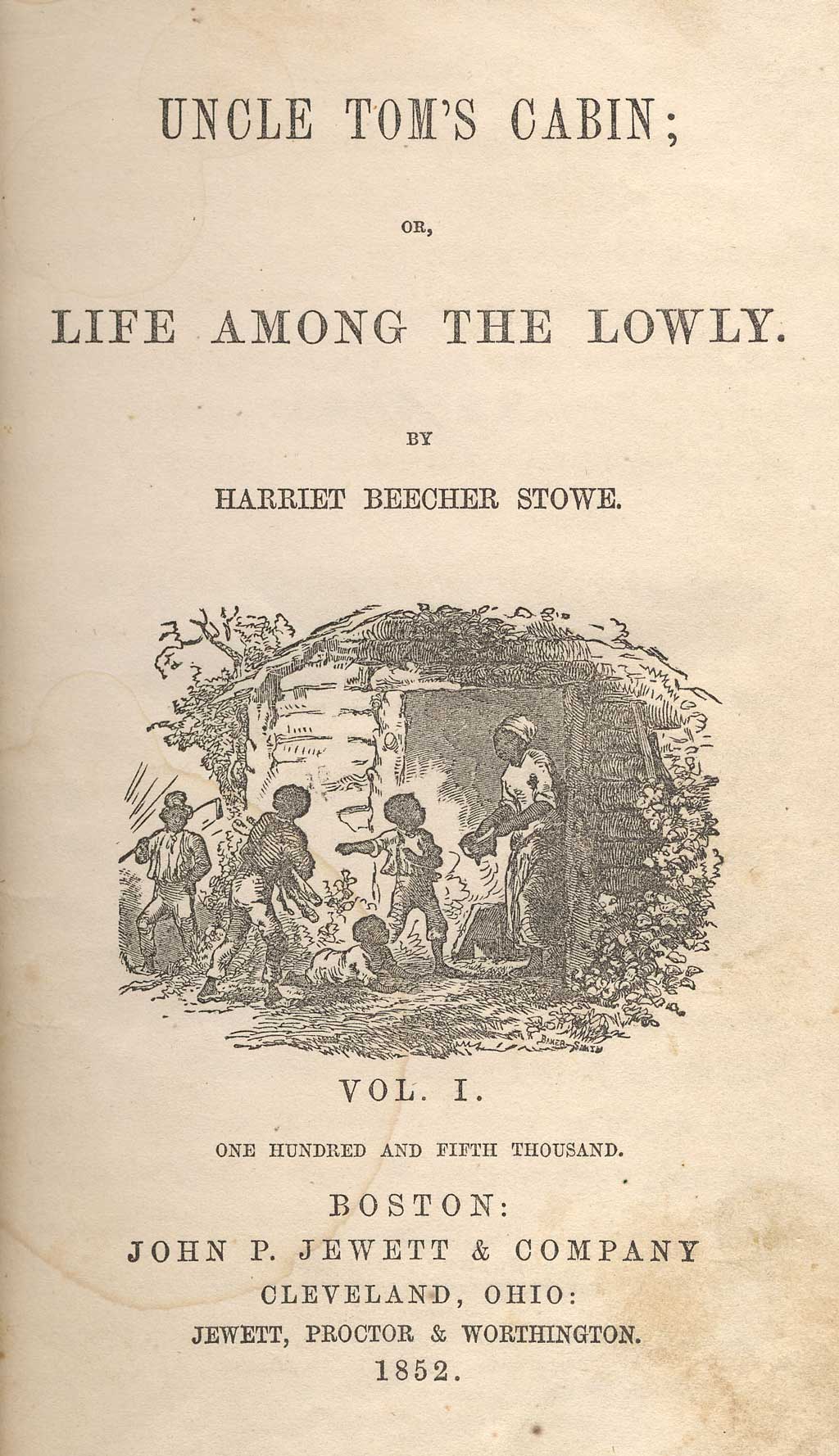
Democrats by 1853 were badly splintered along sectional lines over slavery, but they also had reasons to act with confidence. Voters had returned them to office in 1852 following the bitter fights over the Compromise of 1850. Emboldened, Illinois Senator Stephen A. Douglas (Figure 11) introduced a set of additional amendments to a bill drafted in late 1853 to help organize the Nebraska Territory, the last of the Louisiana Purchase lands. In 1853, the Nebraska Territory was huge, extending from the northern end of Texas to the Canadian Border. Altogether, it encompassed present-day Nebraska, Wyoming, South Dakota, North Dakota, Colorado and Montana. Douglas’s efforts to amend and introduce the bill in 1854 opened dynamics that would break the Democratic Party in two and, in the process, rip the country apart.

Douglas proposed a bold plan in 1854 to cut off a large southern chunk of Nebraska and create it separately as the Kansas Territory. Douglas had a number of goals in mind. The expansionist Democrat from Illinois wanted to organize the territory to facilitate the completion of a national railroad that would flow through Chicago. But before he had even finished introducing the bill, opposition had already mobilized. Salmon P. Chase drafted a response in northern newspapers that exposed the Kansas-Nebraska Bill as a measure to overturn the Missouri Compromise and open western lands for slavery. Kansas-Nebraska protests emerged in 1854 throughout the North, with key meetings in Wisconsin and Michigan. Kansas would become slave or free depending on the result of local elections, elections that would be greatly influenced by migrants flooding to the state to either protect or stop the spread of slavery.
Ordinary Americans in the North increasingly resisted what they believed to be a pro-slavery federal government on their own terms. The rescues and arrests of fugitive slaves Anthony Burns (Figure 12) in Boston and Joshua Glover in Milwaukee, for example, both signaled the rising vehemence of resistance to the nation’s 1850 fugitive slave law. The case of Anthony Burns illustrates how the Fugitive Slave Law radicalized many northerners. On May 24, 1854, 20-year-old Burns, a preacher who worked in a Boston clothing shop, was clubbed and dragged to jail. One year earlier, Burns had escaped slavery in Virginia, and a group of slave catchers had come to return him to Richmond. Word of Burns’ capture spread rapidly through Boston, and a mob gathered outside of the courthouse demanding Burns’ release. Two days after the arrest, the crowd stormed the courthouse and stabbed a Deputy U.S. Marshall to death. News reached Washington, and the federal government sent soldiers. Boston was placed under Martial Law. Federal troops lined the streets of Boston as Burns was marched to a ship where he was sent back to slavery in Virginia. After spending over $40,000, the United States Government had successfully reeenslaved Anthony Burns. The outrage among Bostonians only grew. Anthony Burns was only one of hundreds of highly publicized episodes of the federal governments imposing the Fugitive Slave Law on rebellious northern populations. In the words of Amos Adams Lawrence, “We went to bed one night old-fashioned, conservative, compromise Union Whigs & woke up stark mad Abolitionists.”
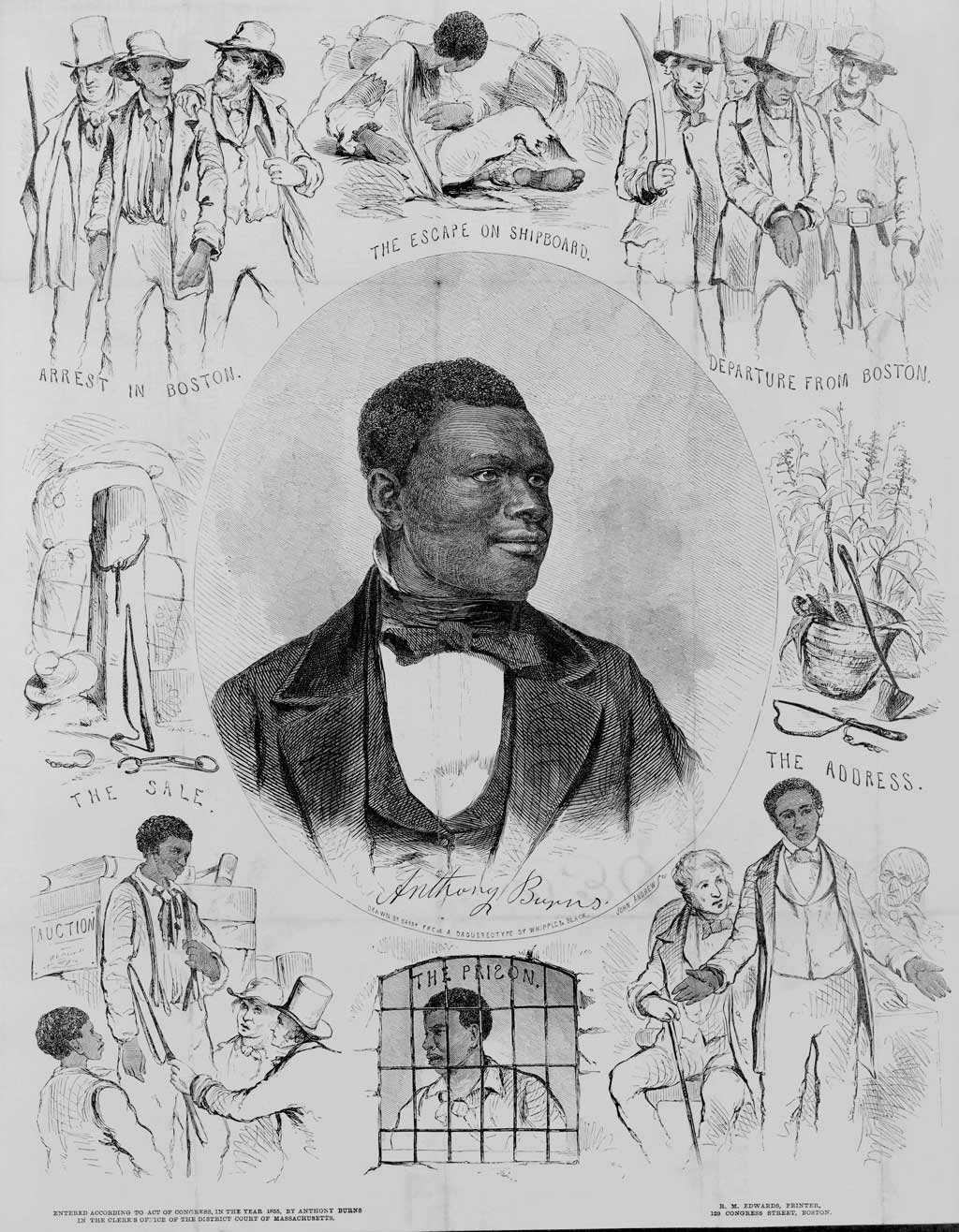
A portrait of the fugitive slave Anthony Burns, whose arrest and trial under the Fugitive Slave Act of 1850 touched off riots and protests by abolitionists and citizens of Boston in the spring of 1854. A bust portrait of the twenty-four-year-old Burns, “Drawn by Barry from a daguereotype [sic] by Whipple and Black,” is surrounded by scenes from his life. These include (clockwise from lower left): the sale of the youthful Burns at auction, a whipping post with bales of cotton, his arrest in Boston on May 24, 1854, his escape from Richmond on shipboard, his departure from Boston escorted by federal marshals and troops, Burns’s “address” (to the court?), and finally Burns in prison. Copyrighting works such as prints and pamphlets under the name of the subject (here Anthony Burns) was a common abolitionist practice. This was no doubt the case in this instance, since by 1855 Burns had in fact been returned to his owner in Virginia.
As northerners radicalized, organizations like the New England Emigrant Aid Society provided guns and other goods for pioneers willing to go to Kansas and establish the territory as anti-slavery through the doctrines of popular sovereignty. On all sides of the slavery issue, politics became increasingly militarized.
The year 1855 nearly derailed the northern anti-slavery coalition. A resurgent anti-immigrant movement briefly took advantage of the Whig collapse, and nearly stole the energy of the anti-administration forces by channeling its frustrations into fights against the large number of mostly Catholic German and Irish immigrants then flooding American cities. Calling themselves “Know-Nothings,” on account of their tendency to pretend ignorance when asked about their activities, the Know-Nothing or American Party made impressive gains, particularly in New England and the Middle Atlantic, in races throughout 1854 and 1855. But the anti-immigrant movement simply could not capture the nation’s attention in the ways the anti-slavery movement already had.
The anti-slavery political movements that started in 1854 and 1855 coalesced as the coming Presidential election of 1856 accelerated the formation of a political party. Harkening back to the founding fathers, this new party called itself the Republican Party. After a thrilling convention that helped launch the national party at Pittsburgh in February, Republicans moved into a highly charged summer expecting great things for their cause. Following an explosive speech before Congress on May 19-20, Charles Sumner was beaten by congressional representative Preston Brooks of South Carolina right on the floor of the Senate chamber. Among other accusations, Sumner accused Senator Andrew Butler of South Carolina of defending slavery so he could have sexual access to black women. Butler’s cousin, representative Brooks felt that he had to defend his relative’s honor, and nearly killed Sumner as a result.
The violence in Washington pales before the many murders occurring in Kansas. Proslavery raiders attacked Lawrence, Kansas. Radical abolitionist John Brown (Figure 13) retaliated, murdering several pro-slavery Kansans in retribution. As all of this played out, the House failed to expel Brooks. Brooks resigned his seat anyway, only to be re-elected by his constituents later in the year. He received new canes emblazoned with the words “Hit him again!”
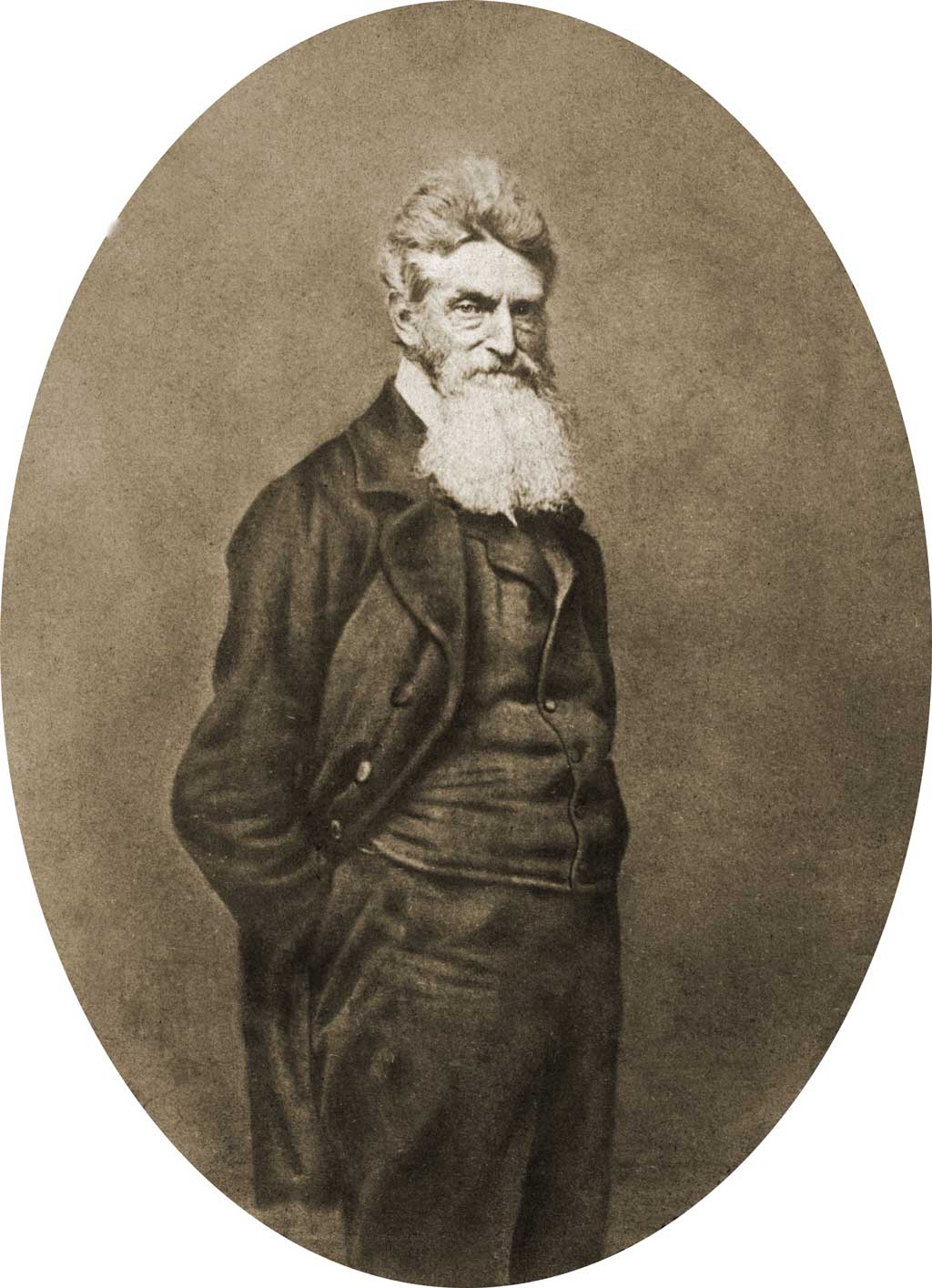
With sectional tensions at a breaking point, both parties readied for the coming Presidential election. In June 1856, the newly named Republican Party held its nominating national convention at Philadelphia, and selected Californian John Charles Frémont. Frémont’s anti-slavery credentials may not have pleased many abolitionists, but his dynamic and talented wife, Jessie Benton Frémont, appealed to more radical members of the coalition. The Kansas-Nebraska Debate, the organization of the Republican Party, and the 1856 Presidential Campaign all energized a new generation of political leaders, including Abraham Lincoln. Beginning with his speech at Peoria, Illinois, in 1854, Lincoln carved out a message that encapsulated better than anyone else the main ideas and visions of the Republican Party. Lincoln himself was slow to join the coalition, yet by the summer of 1856, Lincoln had fully committed to the Frémont campaign.
Despite a tremendous outpouring of support, John Frémont went down in defeat in the 1856 Presidential Election. Republicans took comfort in pointing out that Frémont had in fact won 11 of the 16 free states. This showing, they urged, was truly impressive for any party making its first run at the Presidency. Yet northern Democrats in crucial swing states remained unmoved by the Republican Party’s appeals. Ulysses S. Grant of Missouri, for example, worried that Frémont and Republicans signaled trouble for the Union itself. Grant voted for the Democratic candidate, James Buchanan, believing a Republican victory might bring about disunion. In abolitionist and especially free black circles, Frémont’s defeat was more than a disappointment. Believing their fate had been sealed as permanent non-citizens, some African Americans would consider foreign emigration and colonization. Others began to explore the option of more radical and direct action against the Slave Power. (3)
- The American YAWP. Located at: http://www.americanyawp.com/. License: CC BY-SA: Attribution-ShareAlike

